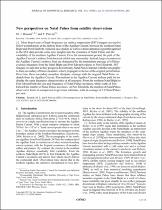JavaScript is disabled for your browser. Some features of this site may not work without it.
- ResearchSpace
- →
- Research Publications/Outputs
- →
- Journal Articles
- →
- View Item
| dc.contributor.author |
Rouault, Marjolaine J

|
|
| dc.contributor.author |
Penven, P

|
|
| dc.date.accessioned | 2012-03-27T11:07:27Z | |
| dc.date.available | 2012-03-27T11:07:27Z | |
| dc.date.issued | 2011-07 | |
| dc.identifier.citation | Rouault, M.J., and Penven, P. 2011. New perspectives on Natal Pulses from satellite observations. Journal of Geophysical Research: Oceans, vol. 116, pp C07013 | en_US |
| dc.identifier.issn | 0148-0227 | |
| dc.identifier.uri | http://www.agu.org/pubs/crossref/2011/2010JC006866.shtml | |
| dc.identifier.uri | http://hdl.handle.net/10204/5684 | |
| dc.description | Copyright: 2011 AGU | en_US |
| dc.description.abstract | More than 6 years of high-frequency sea surface temperature (SST) imagery are used to follow perturbations at the inshore front of the Agulhas Current, between the northern Natal Bight and Port Elizabeth. Selected case studies as well as a front detection algorithm applied to the SST data provide some new insights into the dynamics of Natal Pulses and the variability of the northern Agulhas Current. Over the measurement period, the path of the Agulhas Current’s inshore front does not exhibit any seasonality. Instead, large excursions in the Agulhas Current’s inshore front are dominated by the intermittent passage of offshore cyclonic meanders from the Natal Bight and Port Edward regions to Port Elizabeth. SST imagery reveals that as they progress downstream, Natal Pulses interact with the topography to form secondary offshore meanders which propagate in the lee of the original perturbation. Over time, these secondary meanders dissipate, remerge with the original Natal Pulse, or detach from the Agulhas Current. Fluctuations in the Agulhas Current inshore path do not display the same frequency characteristics at all transects. From the northern Natal Bight to Port Edward both the size and frequency of Natal Pulses increases, while south of Port Edward the number of Natal Pulses decreases. At Port Elizabeth, the number of Natal Pulses observed is lower in comparison to previous estimates, with an average of 1.6 Natal Pulses per year. | en_US |
| dc.language.iso | en | en_US |
| dc.publisher | American Geophysical Union | en_US |
| dc.relation.ispartofseries | Workflow;7028 | |
| dc.subject | Natal Pulses | en_US |
| dc.subject | Sea surface temperature (SST) | en_US |
| dc.subject | Natal bight | en_US |
| dc.subject | Agulhas current | en_US |
| dc.title | New perspectives on Natal Pulses from satellite observations | en_US |
| dc.type | Article | en_US |
| dc.identifier.apacitation | Rouault, M. J., & Penven, P. (2011). New perspectives on Natal Pulses from satellite observations. http://hdl.handle.net/10204/5684 | en_ZA |
| dc.identifier.chicagocitation | Rouault, Marjolaine J, and P Penven "New perspectives on Natal Pulses from satellite observations." (2011) http://hdl.handle.net/10204/5684 | en_ZA |
| dc.identifier.vancouvercitation | Rouault MJ, Penven P. New perspectives on Natal Pulses from satellite observations. 2011; http://hdl.handle.net/10204/5684. | en_ZA |
| dc.identifier.ris | TY - Article AU - Rouault, Marjolaine J AU - Penven, P AB - More than 6 years of high-frequency sea surface temperature (SST) imagery are used to follow perturbations at the inshore front of the Agulhas Current, between the northern Natal Bight and Port Elizabeth. Selected case studies as well as a front detection algorithm applied to the SST data provide some new insights into the dynamics of Natal Pulses and the variability of the northern Agulhas Current. Over the measurement period, the path of the Agulhas Current’s inshore front does not exhibit any seasonality. Instead, large excursions in the Agulhas Current’s inshore front are dominated by the intermittent passage of offshore cyclonic meanders from the Natal Bight and Port Edward regions to Port Elizabeth. SST imagery reveals that as they progress downstream, Natal Pulses interact with the topography to form secondary offshore meanders which propagate in the lee of the original perturbation. Over time, these secondary meanders dissipate, remerge with the original Natal Pulse, or detach from the Agulhas Current. Fluctuations in the Agulhas Current inshore path do not display the same frequency characteristics at all transects. From the northern Natal Bight to Port Edward both the size and frequency of Natal Pulses increases, while south of Port Edward the number of Natal Pulses decreases. At Port Elizabeth, the number of Natal Pulses observed is lower in comparison to previous estimates, with an average of 1.6 Natal Pulses per year. DA - 2011-07 DB - ResearchSpace DP - CSIR KW - Natal Pulses KW - Sea surface temperature (SST) KW - Natal bight KW - Agulhas current LK - https://researchspace.csir.co.za PY - 2011 SM - 0148-0227 T1 - New perspectives on Natal Pulses from satellite observations TI - New perspectives on Natal Pulses from satellite observations UR - http://hdl.handle.net/10204/5684 ER - | en_ZA |






